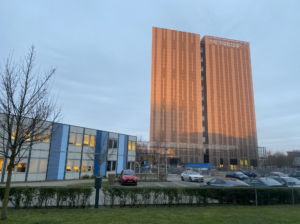The National Institute for Subatomic Physics Nikhef will build a unique vertical particle accelerator in the neighboring Amsterdam Data Tower at the science park. Researchers want to use the new GRAP accelerator to directly explore the interface between gravity and quantum particles.

With the GRAP (GRavity Accelerating Protons) facility, Amsterdam Science Park will again have its own particle accelerator for the first time since 1999. In that year, Nikhef’s MEA/AmPS accelerator was dismantled in a tunnel along the ring dike and sold in parts to institutes abroad. Some components of the machine have been retrieved and will be used again in the new accelerator.
Shaft
Today, Nikhef and Digital Reality, the owner of the high data center, will sign the agreement for the project that will be realized over the next five years. The facility will be placed in a shaft through the eleven floors of the building and will be controlled from the adjacent Nikhef building. Construction will begin during 2023, once the current renovation of the Nikhef building is complete.
“An important step for fundamental physics and an investment in healthy interrelationships at the Science Park,” Nikhef director Prof. Stan Bentman calls the public-private partnership with Digital Reality.
Open question
GRAP will be the world’s first vertical accelerator. In the machine, protons will be shot downward with relatively little energy. This will allow subtle effects of gravity on the falling particles to be measured. “Quantum gravitation is one of the great open questions of physics,” says Nikhef project manager Auke-Pieter Konijn. “Whoever finds something new in it is putting themselves on the scientific map in a huge way.”
At 70 meters, Digital Reality’s Amsterdam Data Tower is the tallest commercial data center in the Amsterdam region, facilitating the Internet connections of more than 100 companies. The striking eleven-story tower stands on one of the main lines of the Internet in Europe. Before the tower’s arrival, this so-called backbone lay for more than a decade in the abandoned concrete tunnel once built for the MEA/AmPS particle accelerator at Nikhef.
Decelerator
The GRAP accelerator uses techniques developed in recent years at the University of Groningen, one of Nikhef’s partners, among others. There, molecules of barium fluoride are electrically decelerated in a short set-up to study the shape of electrons within them. This is another big open question in physics, says Prof Steven Hoekman of the eEDM project in Groningen.
Hoekman: “It’s wonderful to see that we can now also start contributing to a second fundamental question in physics: the relationship of particles to gravity. That’s what you do it for, after all.”